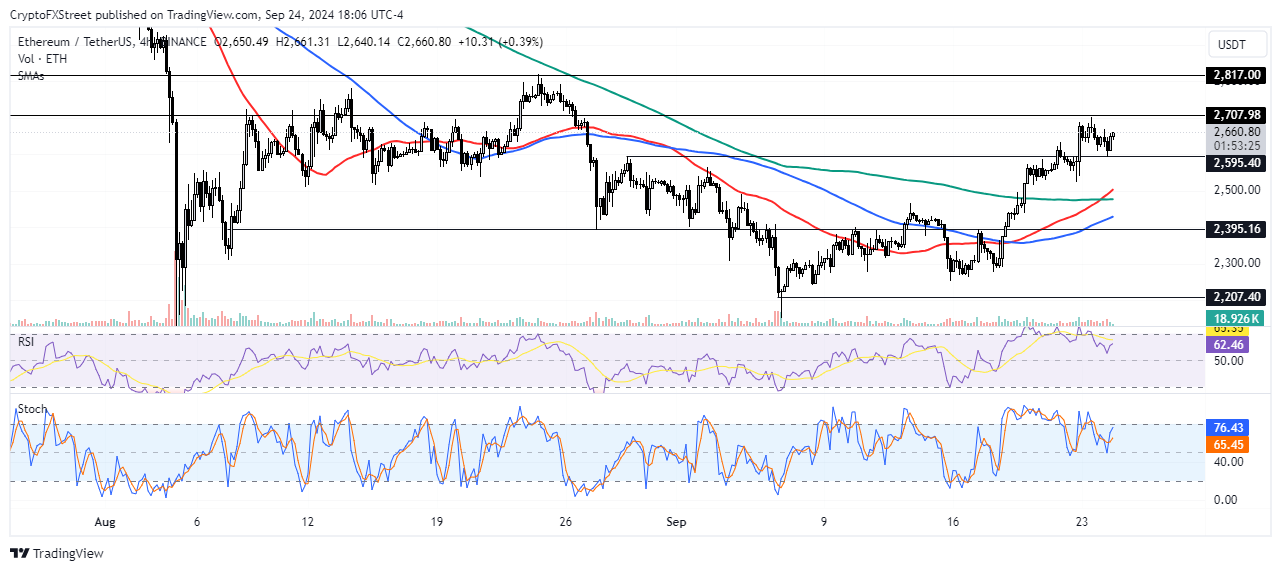Ethereum could rally if it clears $2,707 resistance amid SEC delaying decision on BlackRock's ETH ETF options
- SEC postpone decision on BlackRock's application for options trading on its Ethereum Trust.
- Ethereum exchanges added over 100K ETH to their balance in the past 24 hours.
- Ethereum could sustain bullish momentum if it breaks above the $2,707 key resistance.
Ethereum (ETH) is down 0.5% on Tuesday following the Securities and Exchange Commission (SEC) delaying its decision on BlackRock's application to list and trade options contracts on the iShares Ethereum Trust (ETHA).
Ethereum ETF options not coming to the market soon
The SEC postponed its decision on BlackRock's application to list and trade options on the iShares Ethereum ETF (ETHA). Many had anticipated a greenlight after the regulator approved their spot Bitcoin counterparts last week. However, the SEC disappointed investors following the move to delay its decision.
Following this decision, Ethereum ETFs noted a net outflow of $79.3 million on Monday—its highest since late July—after Grayscale's ETHE witnessed an $80.6 million exodus. The net outflows indicate that ETH has yet to sustain a high institutional appeal from traditional investors in the US.
Meanwhile, ETH could witness a brief selling pressure as its exchange reserve has begun rising. The reserve added over 100K ETH within the past 24 hours, indicating a potential upcoming selling pressure, per CryptoQuants data.
A rising exchange reserve signals high selling potential and vice versa for a low reserve.
-638628131720640137.png)
ETH Exchange Reserve
Ethereum needs to overcome $2,707 to sustain bullish view
Ethereum is trading around $2,660 on Tuesday, down 0.5% on the day. In the past 24 hours, ETH sustained over $19.67 million in liquidations, with long and short liquidations accounting for $13.88 million and $5.79 million, respectively.
On the 4-hour chart, ETH is trading within key rectangle boundaries after bouncing off the $2,595 support level. If this support holds, ETH could rally again to reclaim the $2,817 level, which was a major support level for over four months. But it has to overcome a key resistance around $2,707 — where it saw a rejection on Monday — to confirm the bullish move.

ETH/USDT 4-hour chart
QCP Capital analysts also noted that the options data indicates a potential bullish move amid increasing market volatility. "Front end skew for ETH has shifted from puts to calls, while ETH implied vol is trading 9% higher than BTC, suggesting both upside sentiment and higher expected volatility," the analysts noted.
The Relative Strength Index (RSI) and Stochastic Oscillator momentum indicators are above their neutral levels on the 4-hour chart, signaling prevailing bullish pressure.
A daily candlestick close below $2,595 could trigger a bearish view or lead to sustained consolidation.
In the short term, ETH could rise to $2,671 to liquidate positions worth $51.73 million.
Ethereum FAQs
Ethereum is a decentralized open-source blockchain with smart contracts functionality. Serving as the basal network for the Ether (ETH) cryptocurrency, it is the second largest crypto and largest altcoin by market capitalization. The Ethereum network is tailored for scalability, programmability, security, and decentralization, attributes that make it popular among developers.
Ethereum uses decentralized blockchain technology, where developers can build and deploy applications that are independent of the central authority. To make this easier, the network has a programming language in place, which helps users create self-executing smart contracts. A smart contract is basically a code that can be verified and allows inter-user transactions.
Staking is a process where investors grow their portfolios by locking their assets for a specified duration instead of selling them. It is used by most blockchains, especially the ones that employ Proof-of-Stake (PoS) mechanism, with users earning rewards as an incentive for committing their tokens. For most long-term cryptocurrency holders, staking is a strategy to make passive income from your assets, putting them to work in exchange for reward generation.
Ethereum transitioned from a Proof-of-Work (PoW) to a Proof-of-Stake (PoS) mechanism in an event christened “The Merge.” The transformation came as the network wanted to achieve more security, cut down on energy consumption by 99.95%, and execute new scaling solutions with a possible threshold of 100,000 transactions per second. With PoS, there are less entry barriers for miners considering the reduced energy demands.

